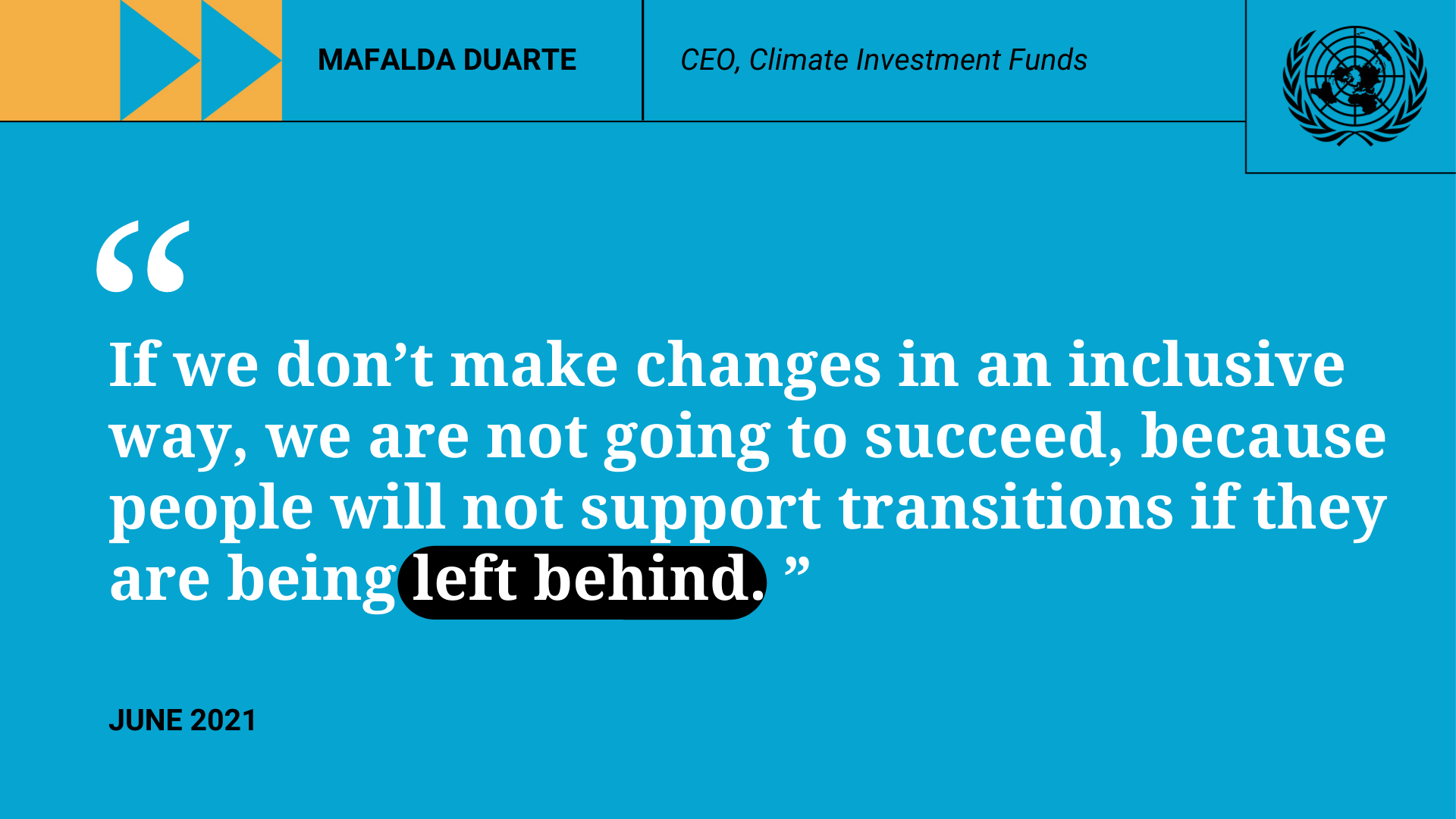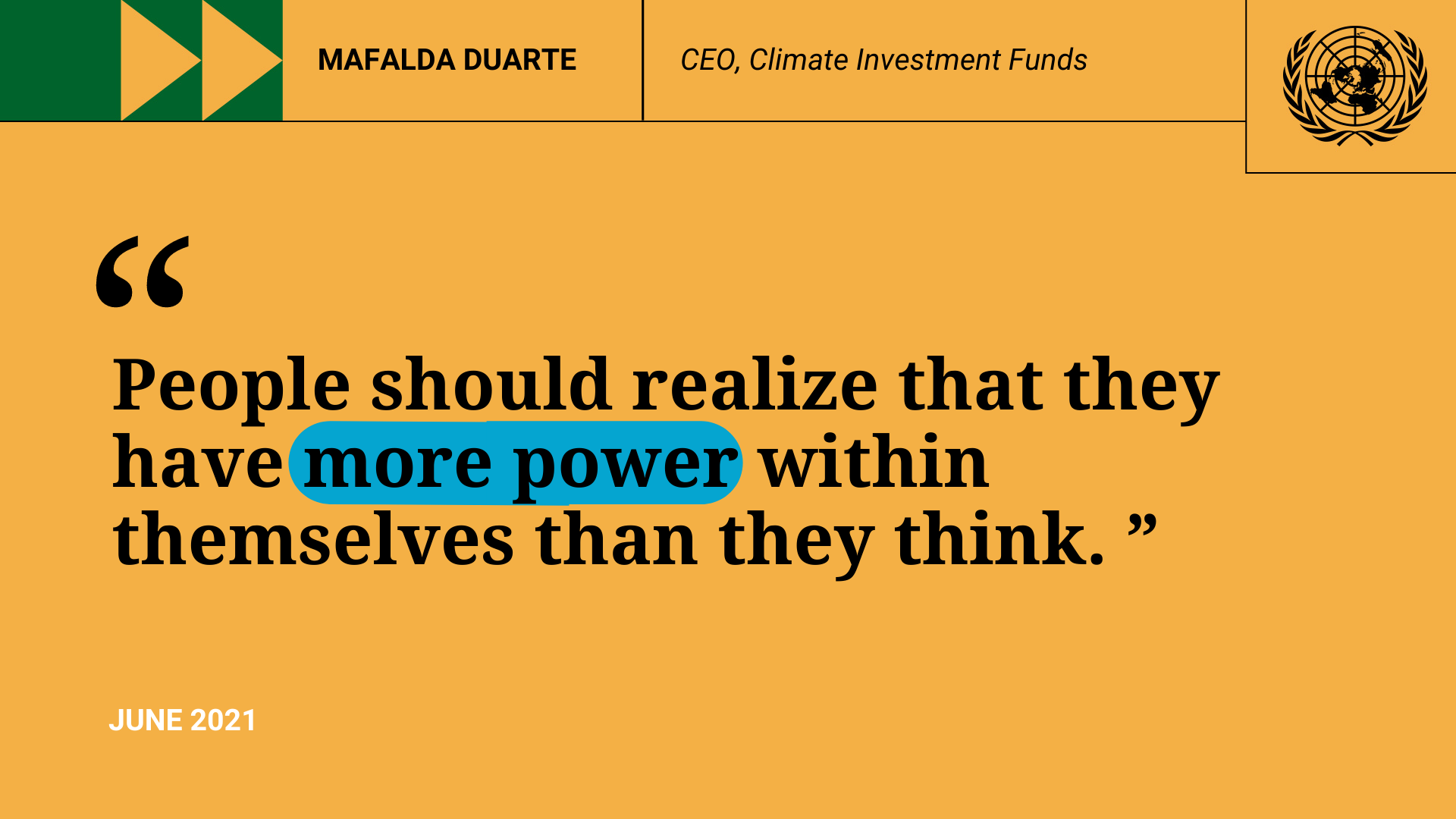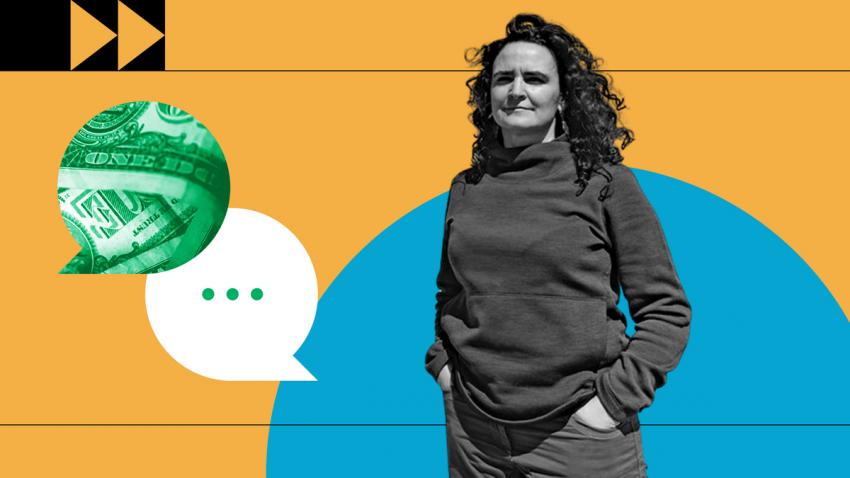Mafalda Duarte heads the Climate Investment Funds, which works with multilateral development banks, governments and communities in developing countries to finance climate solutions. In a recent interview, she spoke about how public climate finance catalyses change and why successful climate action depends fundamentally on social inclusion. The interview has been edited for length and clarity.
How does public climate finance catalyse change?
Let’s think of going to a supermarket where there is a choice between organic apples and normal apples. We may know that organic apples are better for our health but they are more expensive and we cannot afford them. If public resources can come in to influence investment choices that determine how apples are produced, that can turn the economics around to the point where the healthier option becomes the affordable one.
Public climate finance operates along the same lines. Instead of a government deciding to further invest in fossil fuels, it invests in renewable energy, until the economics make the latter the default choice. The fossil fuel industry has been highly subsidized throughout history. We need to do the same with cleaner options given the challenges ahead if we do not.
Since the Climate Investment Funds (CIF) was established in 2008, the cost of renewable energy has come down significantly, even below fossil fuel costs. But this is not the case in all countries. And it’s not just the cost of the technology. There are risks in these markets that make the costs of capital much higher, which has a bearing on the viability of investments. Lower cost public finance can help surmount that obstacle.
Another important part is information. In many places, there is not enough information to understand what climate change is about, how it impacts my life, and what are the opportunities to do things differently. When we work with local commercial banks to translate climate change action into lines of credit for their clients, we also support information campaigns so communities and entrepreneurs understand the options and how those can lead to different outcomes.
You have said that the future of climate action is in developing countries. Why?
Globally, needed infrastructure investments are around $90 trillion by 2030. Two thirds of that is in middle- and low-income countries, with higher population and economic growth rates. With current population growth in Africa and Asia, we are going to have an additional 2.5 billion people in cities in a few decades.
When you make a capital investment decision, you are locking in capital for three, four, five decades or more. We must influence investment decisions right now, because we do not want these to favour high carbon options and not pay enough attention to climate risk.
Many countries have relatively well-developed systems to respond to disasters. This is not so much the case for climate change; even the action plans to implement the Paris Agreement are falling short. What is required to make a clearer case for climate action?
It is a lot easier to relate to disasters because you experience them immediately. Climate change comes to the point where it is irreversible, but is moving more slowly. In general, I don’t think that big scientific messages in international media have necessarily landed the message about the urgency of climate change.
We have to relate to where people are and tailor information to their specific circumstances. Because communities and all countries are experiencing climate change – they are just not calling it climate change. We need to work with governments and communities in translating or connecting global climate phenomena to what they are experiencing, and what can be done at their level to contribute both to socioeconomic development and global climate challenges.
We have found that the moment people understand how to do something different that is better for my community, family and the global good, they will do it. In Ghana, for example, we worked with cocoa producers. They had always assumed that cocoa trees need to be fully exposed to the sun, which caused deforestation. This was not because people did not understand the value of the trees. They did. But they believed that by clearing forests they would get better yields and quality. We were able to explain and demonstrate that in fact they could get better quality cocoa and better income by preserving shade trees. And this would also reduce deforestation and cut contributions to a global problem called climate change.
In meeting climate goals, why is a just transition so important?
We are talking about very significant changes because economies and societies today rely on exploiting natural resources. The shifts are not just in terms of investments, but at all levels, including behaviours, which are difficult to change.
One thing that is very clear is if we don’t make changes in an inclusive way, we are not going to succeed, because people will not support transitions if they are being left behind. At CIF we have focused on two main principles. One is social inclusion. Who do we need to recognize that we haven’t in the past? Are we empowering them? Do they have a say in decisions? A second focus is on distributional impact. As we think about driving renewable energy or energy efficiency, which paths will also tackle social inequalities? Which will aggravate conditions for certain social groups? How can we invest to prevent that from happening?
In South Africa, areas where renewable energy plants can be built are not the same as those with coal-fired power plants. Some regions are reaping the benefits of renewable energy investments; others are not. Communities reliant on coal-fired power plants understand the need to move to clean energy and the environmental and health impacts in their communities. But if they have no opportunities to move to alternative livelihoods or sources of income, there will be opposition to climate goals. In India, the transition from coal is quite complex because it affects the energy sector and other sectors as well. The railways, for instance, derive a lot revenue from transporting coal and subsidize public transport for poor people.
A just transition cuts across all sectors and means we have to look at effects in an economy and society in a very holistic way. We have to tackle changes in policies and regulations and institutional capabilities to carry through reform. We have to think about infrastructure, such as how we repurpose coal-fired power plants. And the third pillar is people and communities having alternative livelihood options and economic opportunities, and bridge support from social protection.

How quickly is business aligning behind climate action?
We are seeing change. The big question is: Will it happen at the needed speed and scale? Our experience has been that if we bring in below-market rate capital and assume certain risks that the private sector cannot take, then businesses will seize opportunities. If we provide finance for the early stages of geothermal development because it is very risky, then the private sector can come in. Aggregating small investments and providing guarantees can lead to issuing bonds on the local market and raising capital. Meeting climate goals depends on these kinds of national and local actions, not just those of the big multinationals.
Another dimension, however, involves the pension and sovereign wealth funds and other types of institutional capital with very significant resources. Even though two thirds of infrastructure investments will happen in middle- and low-income countries, these are markets that institutional capital has not privileged because they have alternative, less risky investment choices. A lot of things need to happen at different levels for them to venture into these markets, including those related to regulation, but I’m hopeful that investors will understand that future economic opportunities depend on alignment with climate goals. Companies that move in another direction will be out of business, sooner or later.
Many COVID-19 recovery plans have fallen far short in emphasizing climate action. Does that surprise you?
This speaks to who we are as humans. In the face of adversity, we are more likely to go with what we know than to think of disruptive ways forward. Every time there is an analysis of recovery packages, we see major investment in industries that are not the industries of the future. It’s a cause for concern.
To some extent, I think we have not fully captured the lessons of COVID-19. The specialists had been warning for some time that this was expected, and that health-care systems would not be prepared. And still, governments did not do what they were being advised to do. The difference between COVID-19 and climate is that while COVID-19 has a very significant impact, we can recover. Climate change is cumulative, potentially reaching a point where the impacts are so great that one cannot really see how to tackle them.
It is not easy, but we really need leaders to have trust in a different future and type of investment. We need leaders who are not considering bailouts for industries or business models that are not viable in the type of world we know we need to create, which is low carbon and net zero by mid-century. There are investment alternatives that can generate recovery while generating jobs. A whole array of investments should be a much greater part of stimulus packages, such as smart grids, low-carbon transport, energy efficiency, hydrogen as a fuel, and nature-based solutions like watershed restoration that are often highly effective in providing jobs.

Why is gender equality central to climate action?
We need both women and men to tackle this challenge. Without gender equality, we lose diversity and different perspectives. Women make decisions differently. We manage differently. We can make powerful contributions as agents of change.
Reaching gender equality means we are more likely to meet climate goals. Climate action can also advance gender equality. We have worked with local financial institutions in Tajikistan, for instance, to structure lines of credit so that women can access finance for climate-related investments. Typically, small women entrepreneurs do not have the information and collateral to get credit. So help desks for women were set up in local commercial banks to provide guidance, and some unconventional collateral requirements were put in place, like accepting jewelry to guarantee a loan. Banks also committed to having women on their staff to work with women entrepreneurs.
This project could have been done in a standard way and would have enhanced finance for climate purposes. But it has gone beyond this goal and is driving shifts in gender norms. Women have become part of decisions around purchasing equipment that they had never been part of before.
Why are you committed to climate action?
I’ve always been driven towards ending poverty and making sure that people have opportunities to pursue the lives they aspire to. I lived for several years in sub-Saharan Africa and saw firsthand the impacts of climate change on people and the environment. Then I went to Asia and saw the same thing. It became clear that if we don’t tackle climate change, nothing else is possible.
If we want to see progress, we have to be deliberate about doing something about it. It is not just going to happen because we talk about it. Talking is important as a first step. If we are persuaded that we need a certain outcome, we then need to act accordingly.
People should realize that they have more power within themselves than they think. We are consumers who make decisions about what we buy and don’t buy, and that certainly influences corporations. Some of us are investors who make investment decisions. We are voters with the power to decide whom we elect and if they stand for what is critical to us. We should never think it is all being decided by governments and private sector institutions. We all, every day of our lives, can make the right choices.




